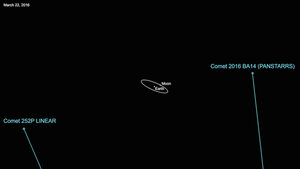Twin comets to careen past Earth
Two comets will safely fly past Earth next week, giving scientists the chance to determine whether they used to be parts of the same comet.

Comet 252P/LINEAR will fly past Earth, Mar. 21, 2016, at a range of roughly 3 million miles. It will be followed by comet P/2016 BA14, which will buzz earth at a distance of 2.2 million miles.
NASA/JPL-Caltech
Astronomers are breaking out the telescopes, metaphoric measuring tapes, and record books for a close visit from two comets next week.
Comets 252O/Linear and P/2016 BA 14 will offer a rare view for scientists as they fly by Earth just one day apart, and only a few million miles away.
The first comet, 252P/LINEAR, will travel past Earth on March 21 at a distance of 3.3 million miles, which is very close on a planetary scale. But the second, P/2015 BA14, could be the record breaker: as it comes within 2.2 million miles of Earth on March 22, it could become the third-closest comet to approach Earth in recorded history.
But don't start digging a comet shelter. Despite the record-setting proximity, most on Earth would still need a professional grade telescope to see either comet, according to NASA.
“March 22 will be the closest comet P/2016 BA14 gets to us for at least the next 150 years," said Paul Chodas, manager of NASA's Center of NEO Studies (CNEOS) at the Jet Propulsion Laboratory, in the press release. "Comet P/2016 BA14 is not a threat. Instead, it is an excellent opportunity for scientific advancement on the study of comets."
Comet 252P/LINEAR was discovered by MIT’s Lincoln Near Earth Asteroid Research (LINEAR) survey in 2000, while P/2015 BA14 was discovered in January by the University of Hawaii’s PanSTARRS telescope in Maui. The second comet was thought to be an asteroid before additional observations identified its tail.
With its newly revised status, P/2015 BA14 becomes a contender for the third closest comet to visit Earth since astronomers began tracking them. Only two recorded comets have come closer – C/1983 H1 (IRAS-Araki-Alcock) in 1983 and D/1770 L1 (Lexell) in 1770.
Their close proximity to each other is also exciting for scientists, who will use the Hubble Space Telescope to examine the relationship between the two comets.
"Comet P/2016 BA14 is possibly a fragment of 252P/LINEAR. The two could be related because their orbits are so remarkably similar," said Dr. Chodas.
"We know comets are relatively fragile things, as in 1993 when comet Shoemaker-Levy 9 was discovered and its pieces linked to a flyby of Jupiter. Perhaps during a previous pass through the inner-solar system, or during a distant flyby of Jupiter, a chunk that we now know of as BA14 might have broken off of 252P."
“Comets split relatively often, but we rarely get a chance to study them soon after it happens, and when we do usually only the bigger fragment survives,” University of Maryland’s Matthew Knight told USA Today.
Although Earth is safe from these twins, some scientists are concerned about other comets impacting Earth.
Some comets circling the Sun beyond Jupiter could be big enough to cause serious damage if they collided with Earth, reported The Christian Science Monitor’s Lucy Schouten in December 2015. But the likelihood of such an impact is low.
Over 90 percent of near Earth objects (NEOs) larger than 1 kilometer – asteroids or comets with the potential to both enter Earth’s area of the solar system and cause serious damage in a collision – are being tracked, according to NASA’s NEO Program.

